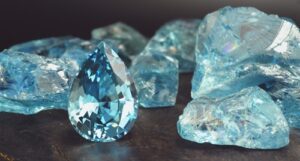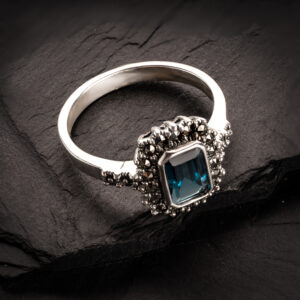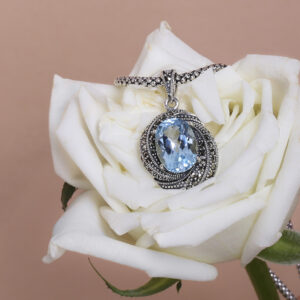Aquamarine, with its soothing sea-blue color, is a gemstone that embodies tranquility, clarity, and emotional harmony. A member of the beryl family—alongside emerald and morganite—aquamarine has been cherished for centuries not only for its beauty but also for its calming metaphysical qualities. This guide explores the physical properties, healing benefits, and diverse uses of aquamarine.
Aquamarine: Properties, Uses, and Benefits

What Is Aquamarine?
Aquamarine is a blue to blue-green variety of beryl (Be₃Al₂Si₆O₁₈). Its name is derived from the Latin words aqua (water) and marina (sea), reflecting its oceanic hues. Most aquamarine crystals form in pegmatite veins and granite rocks and are found in countries like Brazil, Pakistan, Nigeria, and Madagascar.
Physical Properties of Aquamarine
- Mineral Family: Beryl
- Color: Light blue to blue-green
- Hardness: 7.5 to 8 on the Mohs scale
- Luster: Vitreous (glassy)
- Transparency: Transparent to translucent
- Crystal System: Hexagonal
High-quality aquamarines are transparent with minimal inclusions and even color distribution. Heat treatment is commonly used to enhance the blue tone by removing greenish hues.
Symbolism and Meaning
Aquamarine has long been associated with the sea and its calming energy. Symbolically, it represents:
- Courage and Communication: Believed to assist in expressing oneself clearly and confidently
- Peace and Emotional Clarity: Helps soothe stress, fear, and anger
- Protection for Travelers: Historically used by sailors as a talisman against ocean dangers
- March Birthstone: Associated with Pisces and Aries zodiac signs
Metaphysical and Healing Benefits
1. Emotional Healing
- Calms anxiety and overthinking
- Encourages forgiveness and compassion
- Supports emotional release and healing from past trauma
2. Mental Clarity
- Enhances logic, intellect, and quick thinking
- Useful during study or complex decision-making
- Aligns the mind with a calm, balanced perspective
3. Throat Chakra Alignment
Aquamarine is deeply connected to the throat chakra (Vishuddha), which governs communication and self-expression. It supports:
- Honest and kind dialogue
- Resolving conflict with grace
- Public speaking and creative writing
4. Spiritual Growth
- Promotes inner peace and spiritual awareness
- Aids in meditation and mindfulness practices
- Encourages trust in divine timing and guidance
Uses of Aquamarine
- Jewelry: Popular in rings, pendants, earrings, and engagement settings for its durability and brilliance
- Meditation Tools: Used to enhance calm and clarity during spiritual practices
- Decorative Stones: Geodes and polished stones adorn homes and workspaces to bring peaceful energy
- Crystal Healing: Placed on the throat chakra or held during sessions to clear energy blockages
Caring for Aquamarine
Aquamarine is relatively durable but still benefits from gentle care:
- Cleaning: Use lukewarm water, mild soap, and a soft brush
- Avoid: Harsh chemicals, prolonged sun exposure, or sudden temperature changes
- Storage: Keep separately to avoid scratching softer stones
How to Choose Aquamarine
When selecting an aquamarine stone:
- Color: Richer blue hues are more valuable; however, some prefer soft pastel tones
- Clarity: Eye-clean stones with few inclusions are ideal
- Cut: Emerald, oval, and round cuts maximize brilliance
- Origin: Brazilian and Pakistani aquamarines are highly regarded
Aquamarine’s serene energy and elegant appearance make it a versatile gemstone for both adornment and healing. Whether worn as a talisman of tranquility or used to enhance communication and emotional balance, aquamarine continues to captivate hearts across generations. Its connection to the sea, sky, and self-expression offers a powerful reminder to stay calm, speak truthfully, and flow with life’s rhythms.




